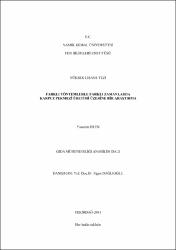| dc.contributor.author | Eren, Yasemin | |
| dc.date.accessioned | 2017-05-08T11:51:40Z | |
| dc.date.available | 2017-05-08T11:51:40Z | |
| dc.date.issued | 2011 | |
| dc.identifier.uri | https://hdl.handle.net/20.500.11776/808 | |
| dc.description.abstract | Bu araştırmada Tekirdağ’da yetiştirilen karpuzlardan klasik ve modern yöntem uygulanarak haziran, temmuz ve ağustos aylarında sıvı pekmez üretimi yapılmıştır. İki farklı üretim yöntemiyle üç farklı zamanda üretilen karpuz pekmezlerinde yapılan fiziksel, kimyasal, mikrobiyolojik ve duyusal analizlerin sonuçları belirlenmiştir. İki yöntemle üç farklı zamanda üretilen karpuz pekmezlerinde yapılan fiziksel, kimyasal ve mikrobiyolojik analizlerin sonuçları istatistik analiz metotları ile değerlendirilmiştir. Karpuz pekmezlerinin analiz sonuçlarında pH 5,19-5,89, suda çözünür kuru madde (SÇKM) % 68-74, toplam şeker % 70,54- 74,68, hidroksimetilfurfural (HMF) 1,63-6,99 mg/kg, renk (L,a,b) 8,92-20,18,(+) 0,98-3,98, 1,20-4,12, viskozite 8450-9550, aerobik koloni sayısı 3,2x10 3 -9,5x103 kob/g, bakır (Cu) 0,154-3,214 mg/kg, demir (Fe) 2,154- 3,562 mg/kg arasında değişmektedir. Okratoksin A, toplam aflatoksin, arsenik (As), kurşun (Pb), kalay (Sn) tespit edilebilir düzeyde bulunamamış, maya-küf ve osmofilik maya analizlerinde üreme tespit edilememiştir. Duyusal analiz sonuçlarına göre renk bakımından temmuz ayında geleneksel yöntemle üretilen karpuz pekmezi en yüksek puanı alırken, tat ve koku bakımından en yüksek puanı ise temmuz ayında modern yöntemle üretilen karpuz pekmezi almıştır. Sonuç olarak, karpuz pekmezlerinden modern yöntemle üretilen karpuz pekmezlerinin özellikleri klasik yöntemle üretilenlere göre daha iyi olduğu belirlenmiştir. | en_US |
| dc.description.abstract | In this research molasses were produced by using watermelons which are grown in Tekirdağ in June, July and August seasons, by applying classical and modern production methods. Physical, chemical, microbiological and sensory analysis were done for two different production methods and three different season’s watermelons. Physical, chemical and microbiological analysis results of molasses produced by two different methods and three different season were evaluated with statistical analysis methods. Watermelon molasses analysis results, were determined as follow. pH is changed 5,19 to 5,89, water soluble solids (WSS) 68-74%, total sugar(%) from 70.54 to 74.68, hydroxymethylfurfural (HMF) 1.63 to 6.99, the color (L, a, b) 8.92 to 20.18, (+) 0.98 to 3.98, 1.20 to 4.12, viscosity 8450 to 9550, aerobic colony count 3200 to 9500 cfu/g, copper (Cu) 0.154 to 3.214 mg/kg, iron (Fe) 2.154 to 3.562 mg/kg. Ochratoxin A, total aflatoxin, arsenic (As), lead (Pb), tin (Sn), osmophilic yeast, mold and yeast could not found at detectable levels. According to the results of sensory analysis; in terms of color, traditional way produced watermelon molasses in July take the highest score, in terms of taste and smell of watermelon molasses produced by modern method and in July take the highest score. As a result, it was determined that the watermelon molasses which produced by modern methods was much better than classical methods. | en_US |
| dc.language.iso | tur | en_US |
| dc.publisher | Namık Kemal Üniversitesi | en_US |
| dc.rights | info:eu-repo/semantics/openAccess | en_US |
| dc.subject | Karpuz | en_US |
| dc.subject | pekmez | en_US |
| dc.subject | HMF | en_US |
| dc.subject | Watermelon | en_US |
| dc.subject | molasses | en_US |
| dc.title | Farklı yöntemlerle farklı zamanlarda karpuz pekmezi üretimi üzerine bir araştırma | en_US |
| dc.title.alternative | A study on watermelon molasses which was produced at different seasons and by different methods | en_US |
| dc.type | masterThesis | en_US |
| dc.department | Enstitüler, Fen Bilimleri Enstitüsü, Gıda Mühendisliği Ana Bilim Dalı | en_US |
| dc.relation.publicationcategory | Tez | en_US |



















